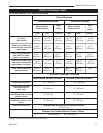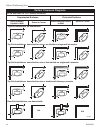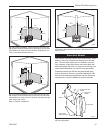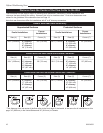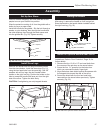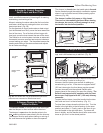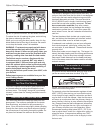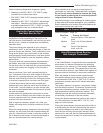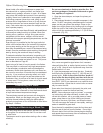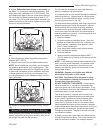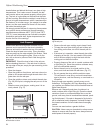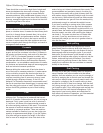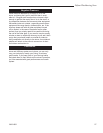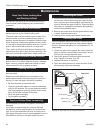
21
Defiant Woodburning Stove
30001693
Most installations do not require a large amount of
combustion air, especially if adequate draft is available.
Do not for any reason attempt to increase the firing
of your heater by altering the air control adjustment
range outlined in these directions.
Use the following air control settings as a starting point
to help determine the best settings for your installation.
Each is described as a fraction of the total distance the
lever may be moved from right to left.
Defiant Control Settings
(Refer to Figure 27, Page 19)
Burn Rate Primary Air Control
Low From far right to 1/3 the distance
to left
Medium From 1/3 to 2/3 the distance
to left
High From 2/3 the distance
to left, to far left
High-Efficiency Wood Burning
with Catalytic Combustion
A Defiant leaves the factory with the combustor in-
stalled.
In the United States, it is against the law to operate this
wood heater in a manner inconsistent with operating
instructions in this manual, or if the catalytic combustor
is deactivated or removed. The components of the cata-
lytic combustion system in your Defiant work together to
produce optimum conditions for secondary combustion.
When the damper is closed, smoke travels through
the catalytic element, which causes ignition of smoke
at temperatures of 500°-600° F (260°-315°C), half the
temperature normally required for unaided secondary
combustion.
The catalytic element is a ceramic “honeycomb” coated
with the catalytic material. The element is located in the
secondary combustion chamber, molded from a special
high-temperature insulating refractory material. The
chamber provides the correct environment necessary
for secondary combustion of the fuel (smoke).
Closing the damper exposes the smoke to the combus-
tor. If the combustor is at least 600°F (315°C), it will
begin to burn the smoke.
Closing the stove damper may also reduce the draft, so
to avoid putting out the fire or deactivating the combus-
tor, close the damper only when a fire is well-estab-
lished and the chimney is thoroughly warmed. When
starting a fire, wait until the fire is well established and
there is an ember bed of at least 3-4 inches before clos-
ing the damper.
Use the following temperature ranges as a guide:
• Readings in the 350°-500°F. (175°-260°C) range
indicate low to medium heat output.
• 500°-600°F. (260°-315°C) readings indicate medium
heat output.
• Readings of 600°-750°F. (315-385°C) indicate high
heat output. Operating your Defiant continuously
at griddle temperatures of 750° F. (385°C) or higher
may damage the cast iron or enamel finish.
Use the Air Control Settings
that Work Best for You
No single air control setting will fit every situation. Each
installation will differ depending on the quality of the
fuel, the amount of heat desired, and how long you wish
the fire to burn; outdoor air temperature and pressure
also affect draft.
The control setting also depends on your particular
installation’s “draft,” or the force that moves air from the
stove up through the chimney. Draft is affected by such
things as the length, type, and location of the chimney,
local geography, nearby obstructions, and other factors.
See Page 26 for details on how the installation affects
performance.
Too much draft may cause excessive temperatures in
the Defiant, and could even damage the combustor.
On the other hand, too little draft can cause backpuffing
into the room and/or the “plugging” of the chimney or
combustor.
How do you know if your draft is excessively high or
low? Symptoms of too much draft include an uncontrol-
lable burn or a glowing-red stove part. Signs of weak
draft are smoke leaking into the room through the stove
or chimney connector joints, low heat, and dirty glass.
In some newer homes that are well-insulated and
weather-tight, poor draft may result from insufficient air
in the house. In such instances, an open window near
the stove on the windward side of the house will provide
the fresh air needed.
Another option for getting more combustion air to the
stove is to duct air directly from the outside to the stove.
In some areas provisions for outside combustion air are
required in all new construction.
With an optional outside air adapter, No. 1904, your
Defiant will accept a duct to deliver outside air for com-
bustion.
When first using the stove, keep track of the air control
settings. You will quickly find that a specific setting will
give you a fixed amount of heat. It may take a week or
two to determine the amount of heat and the length of
burn you should expect from various settings.



